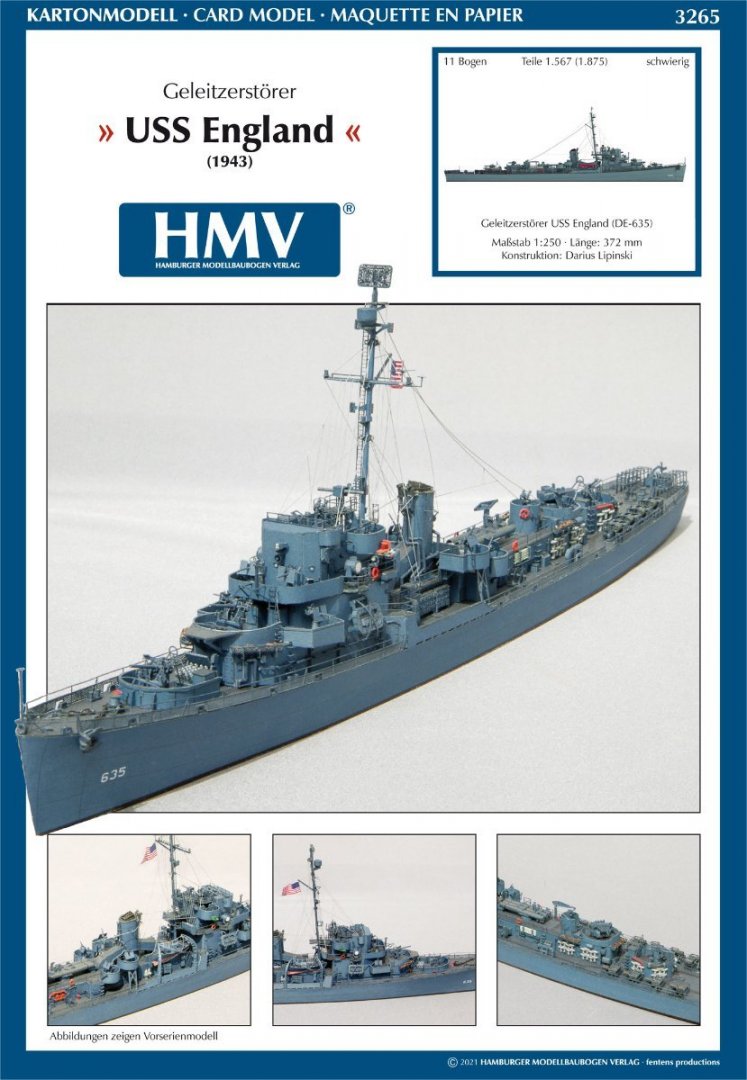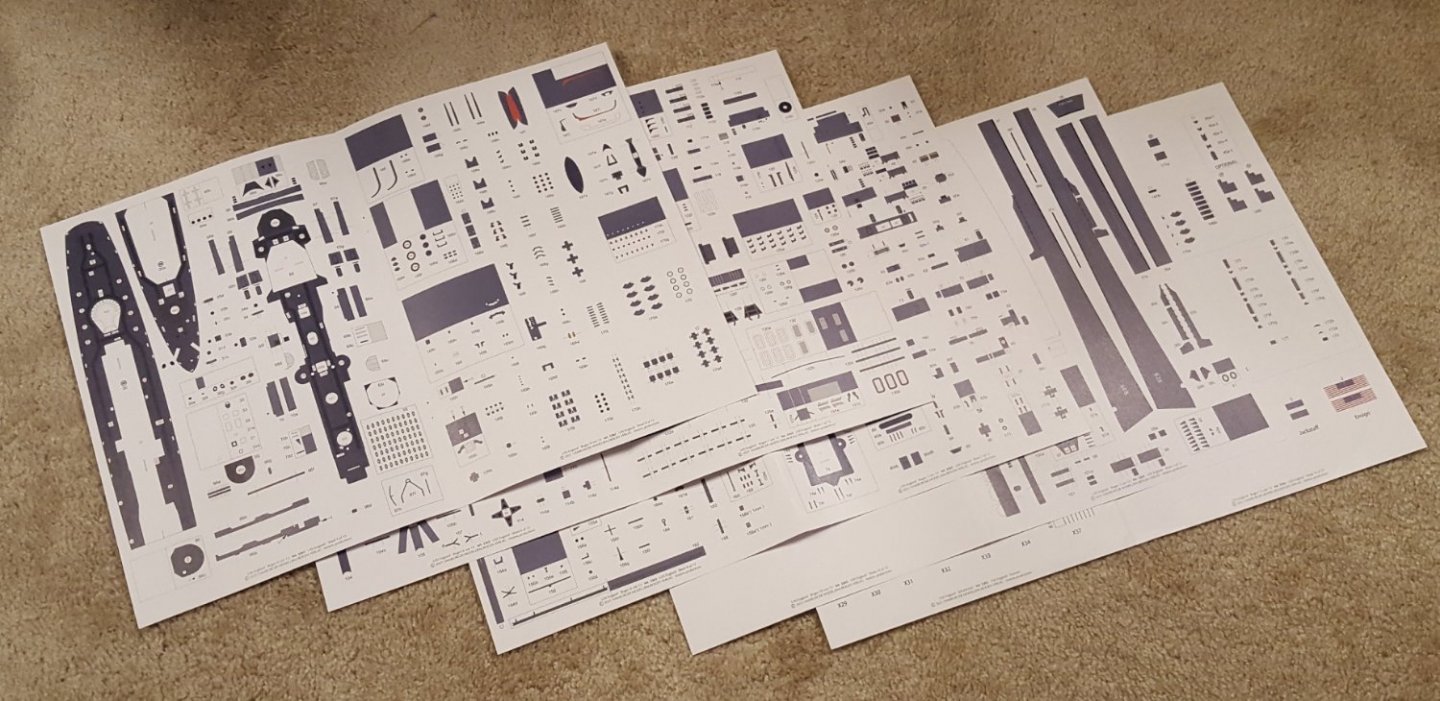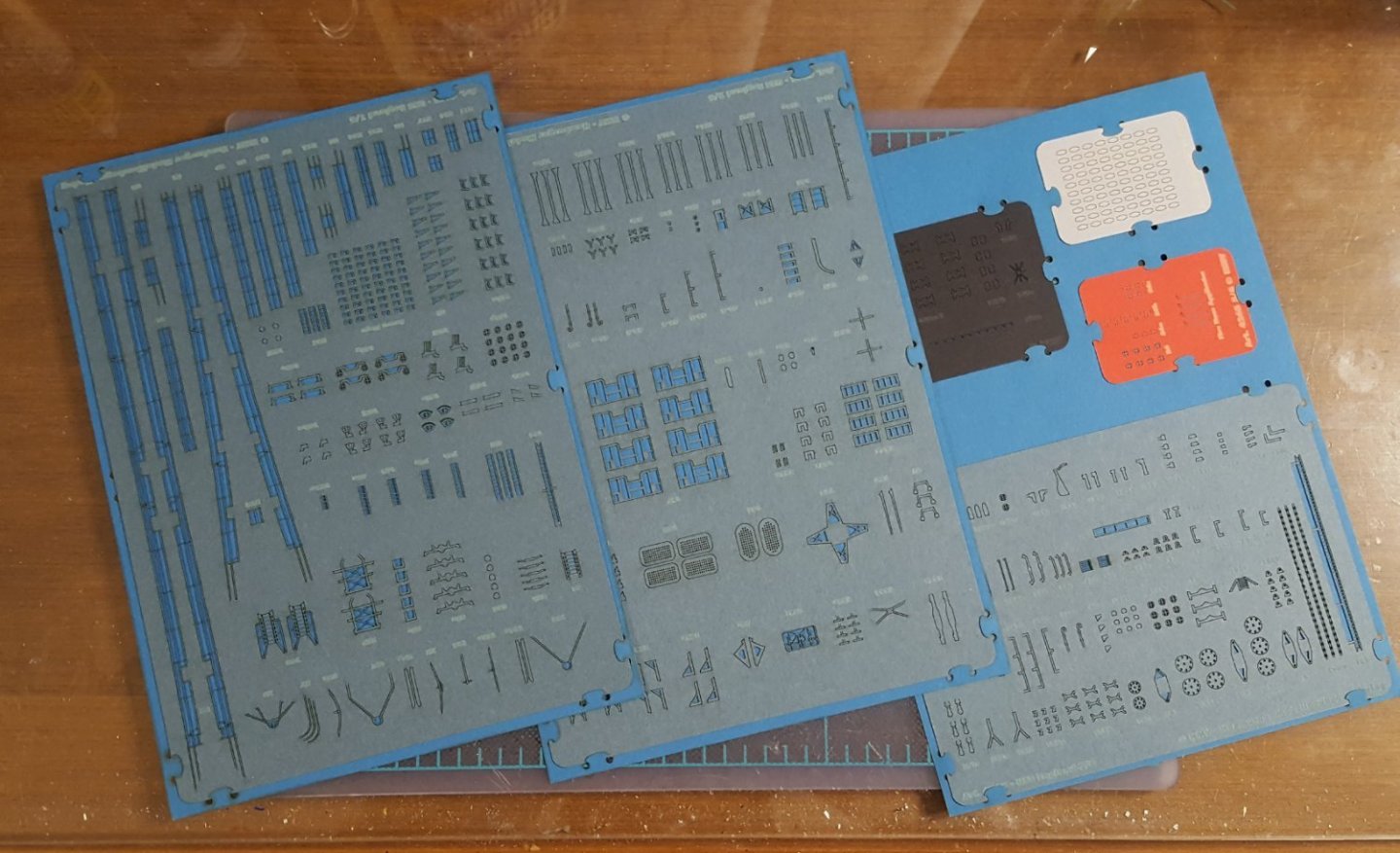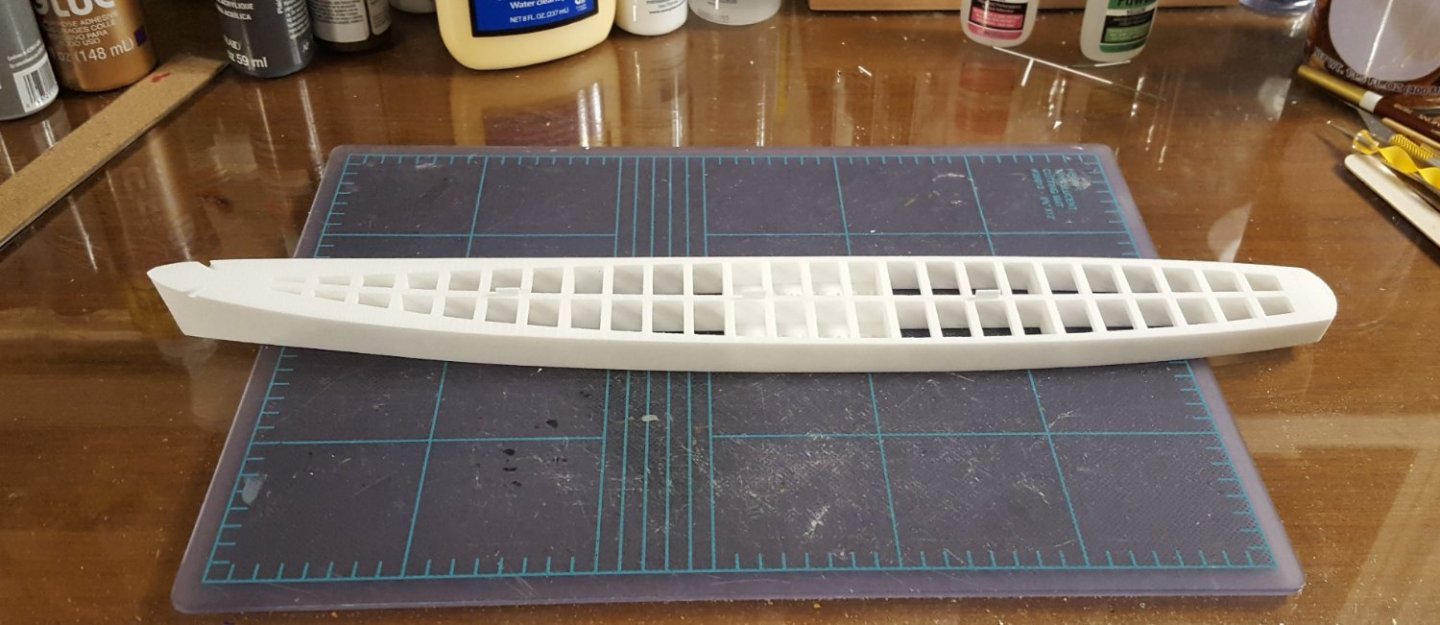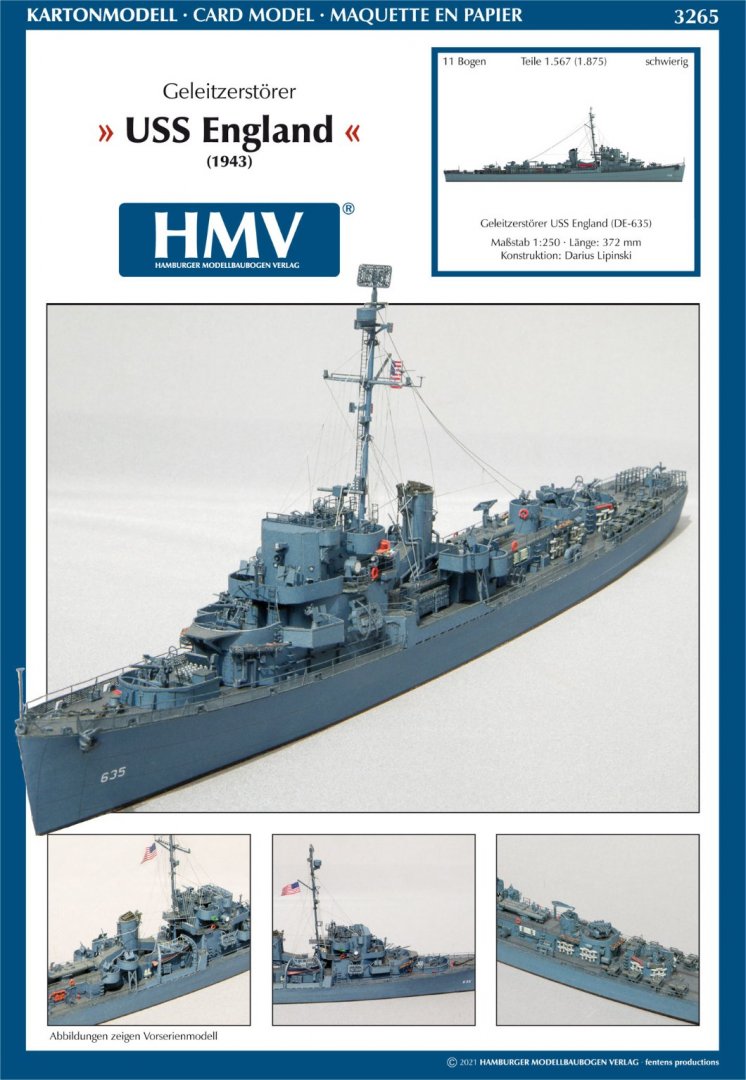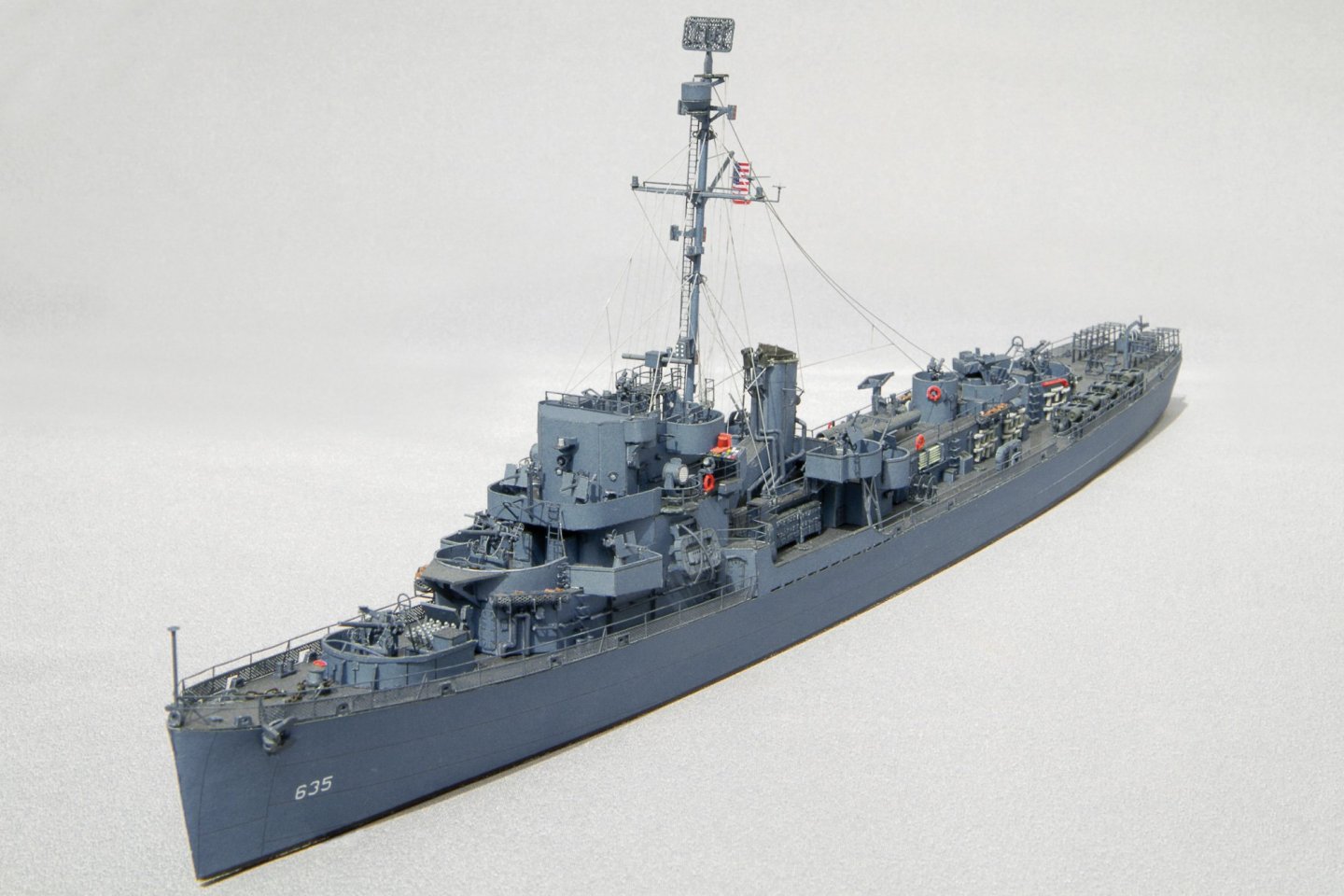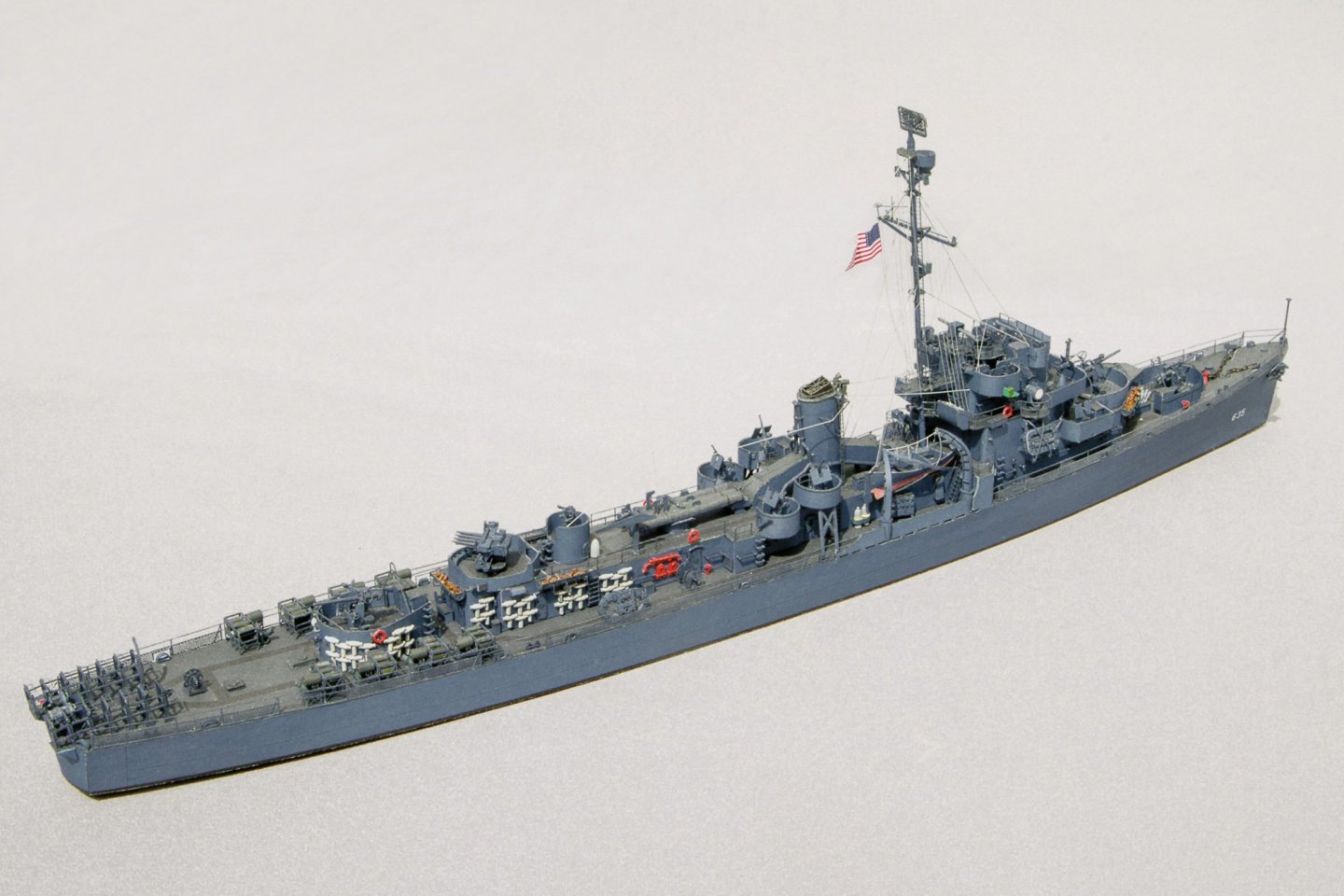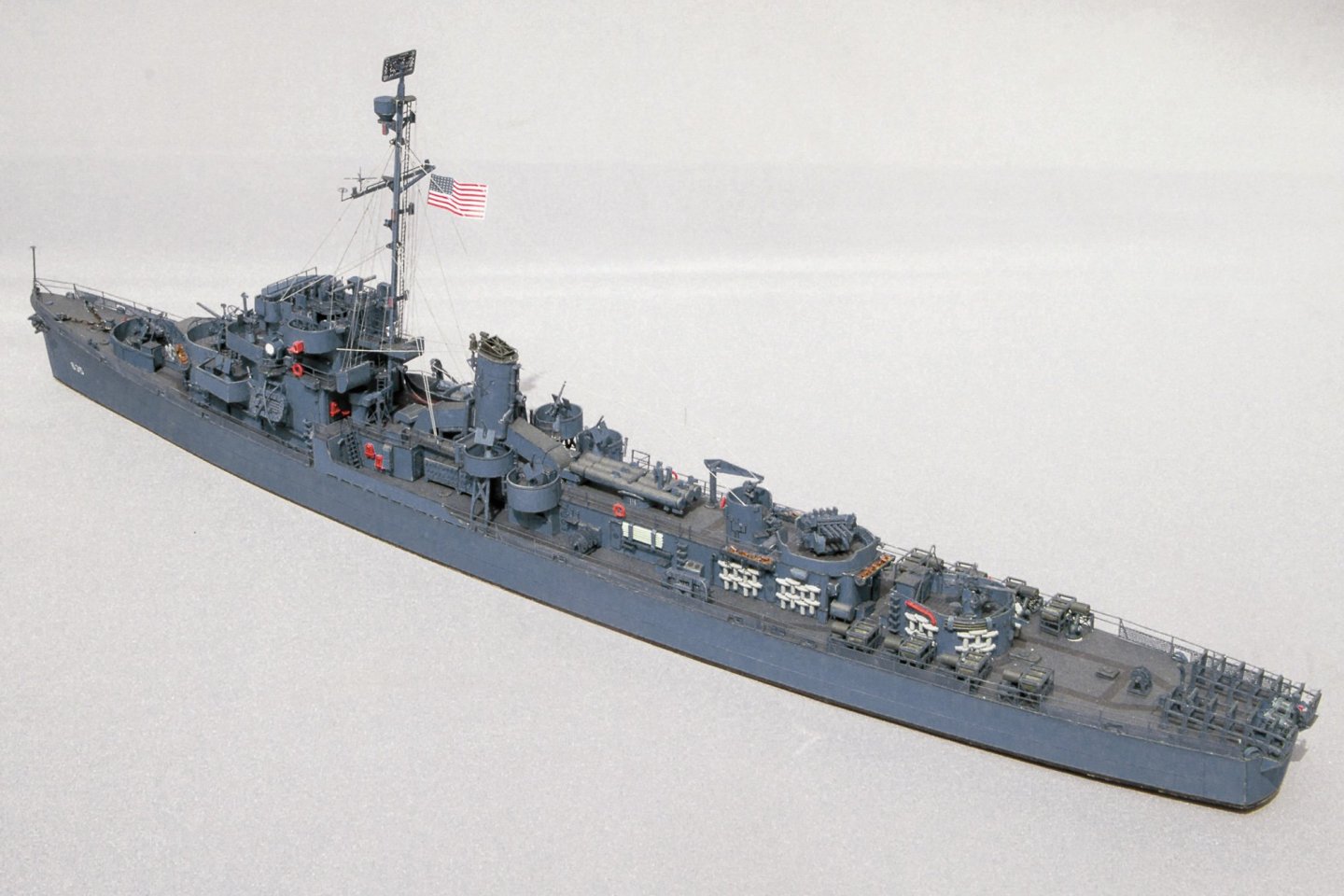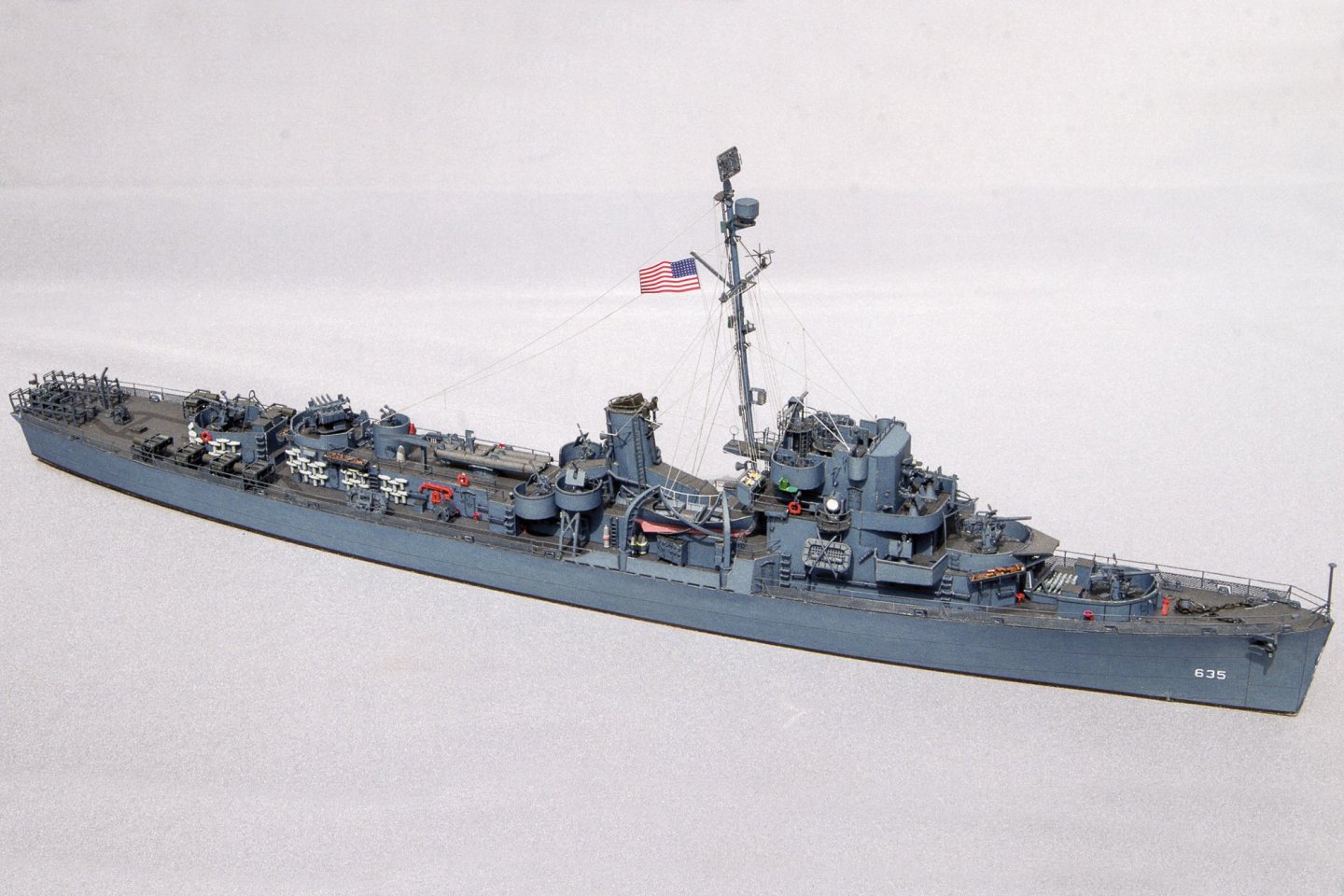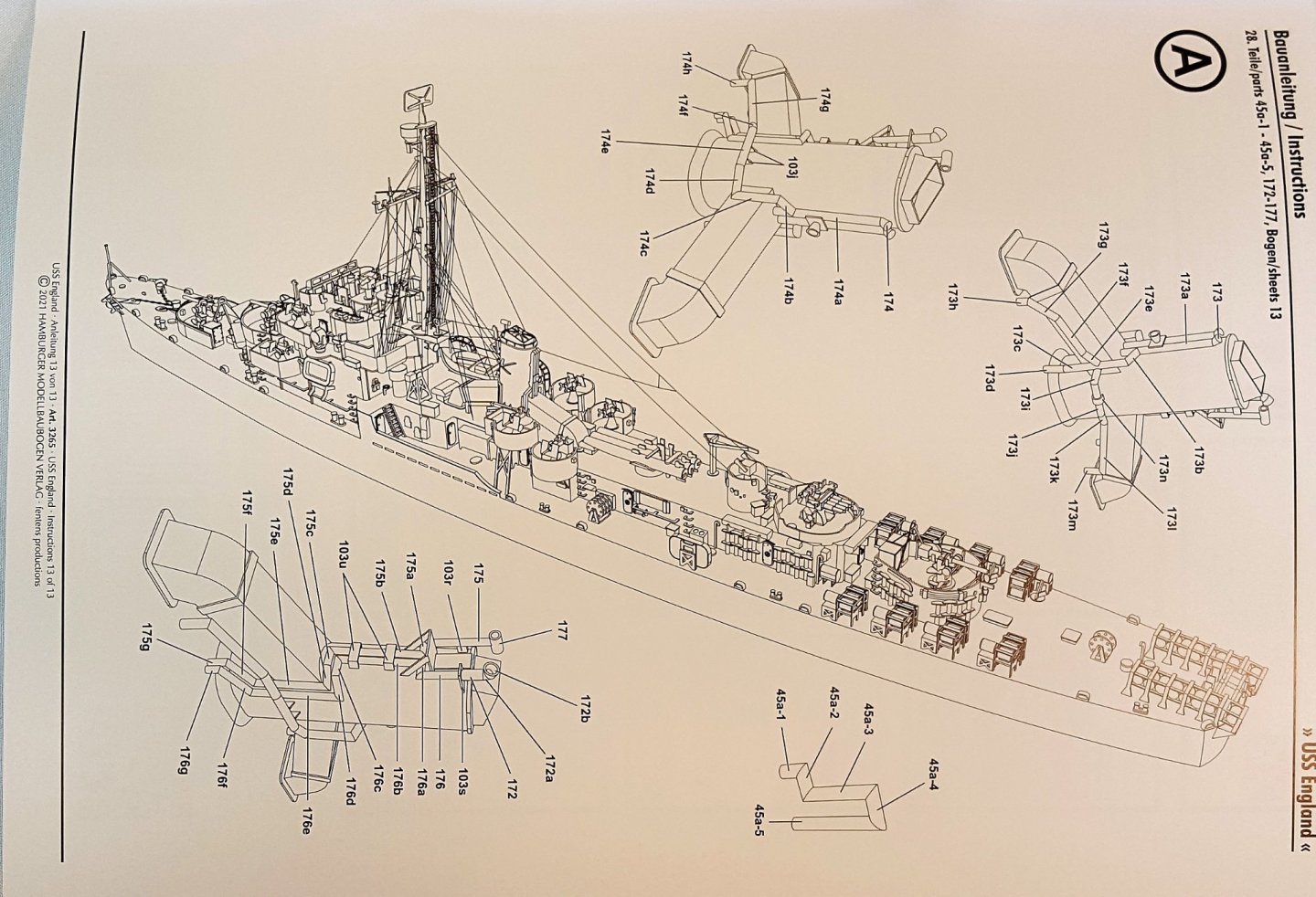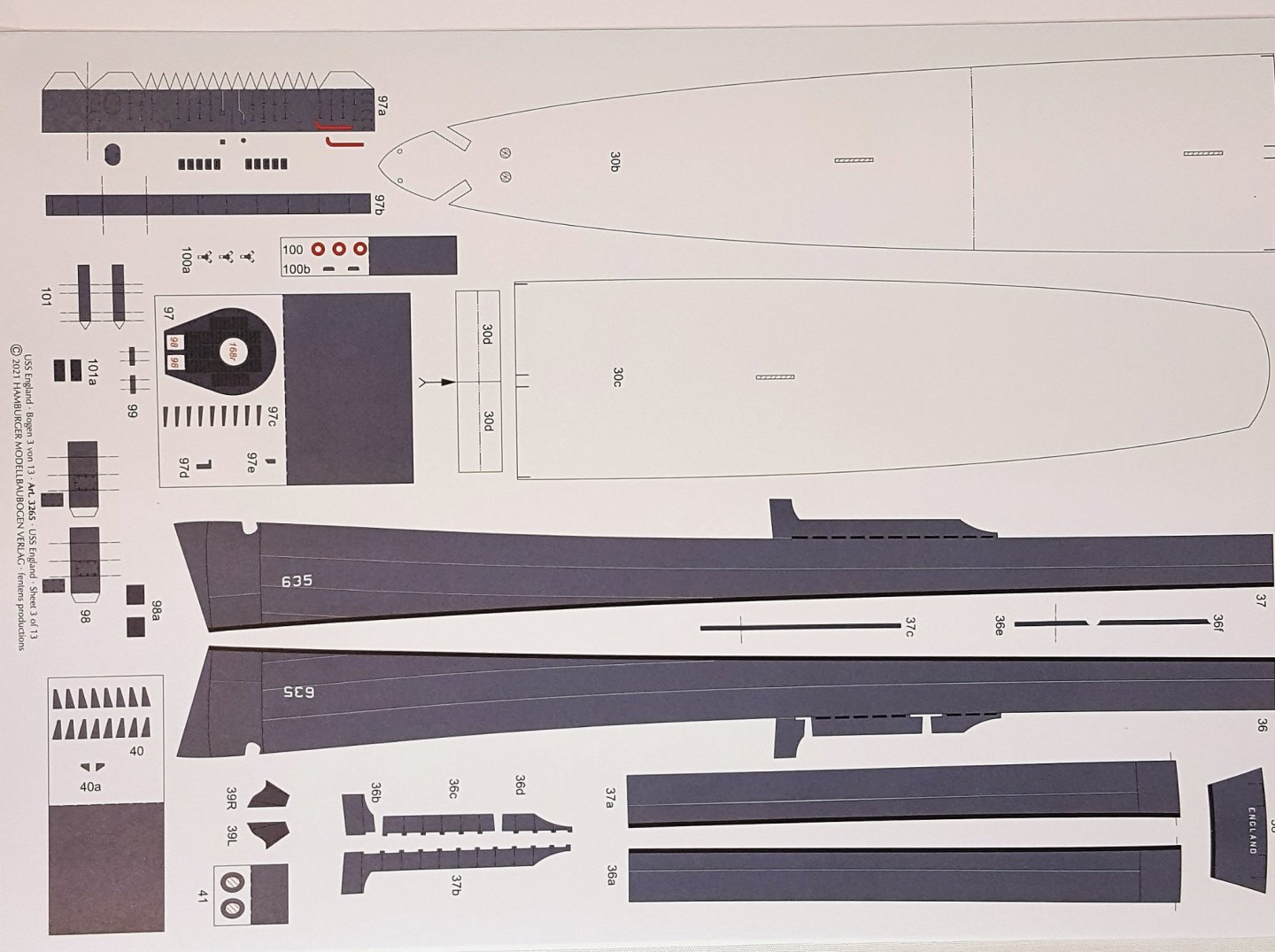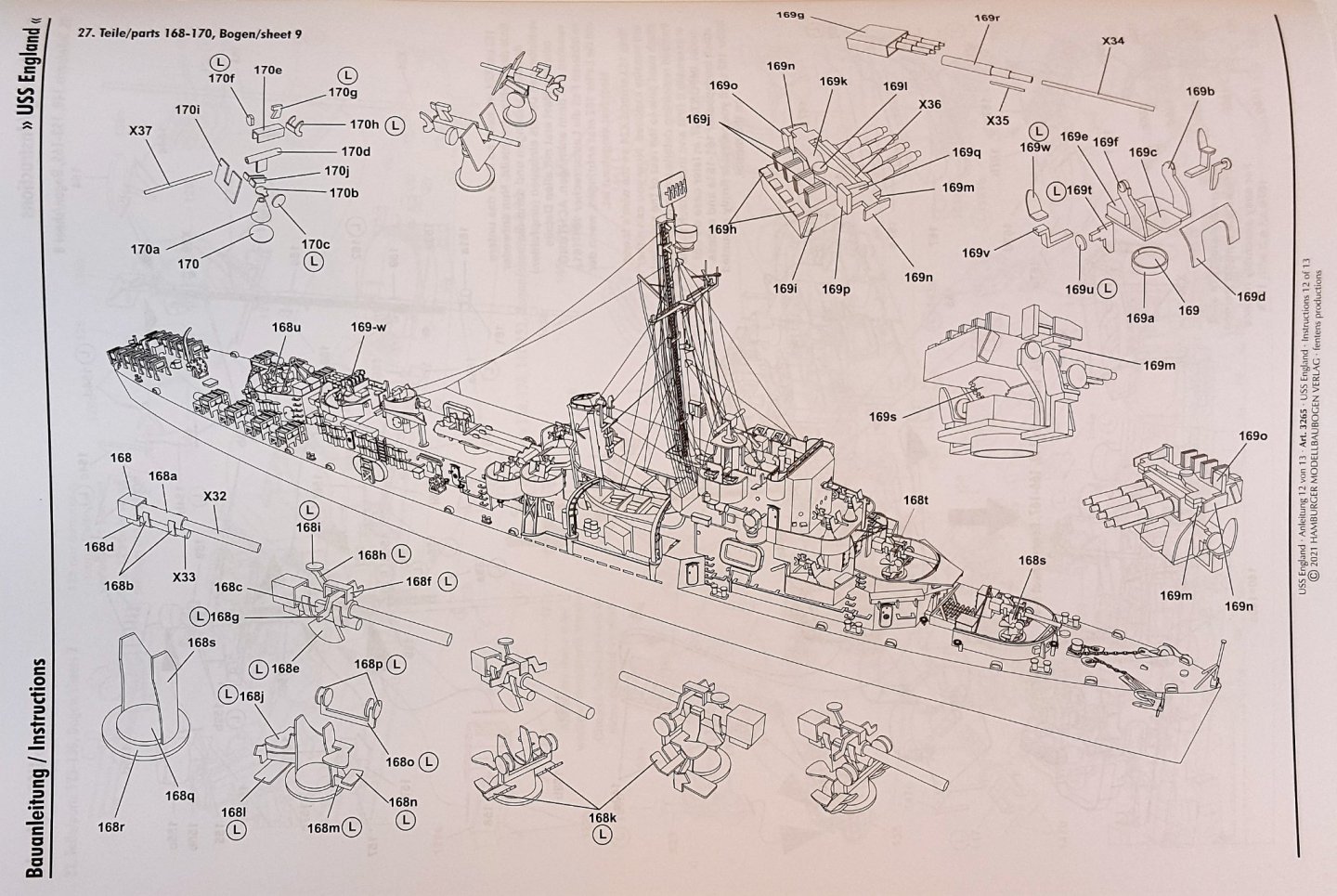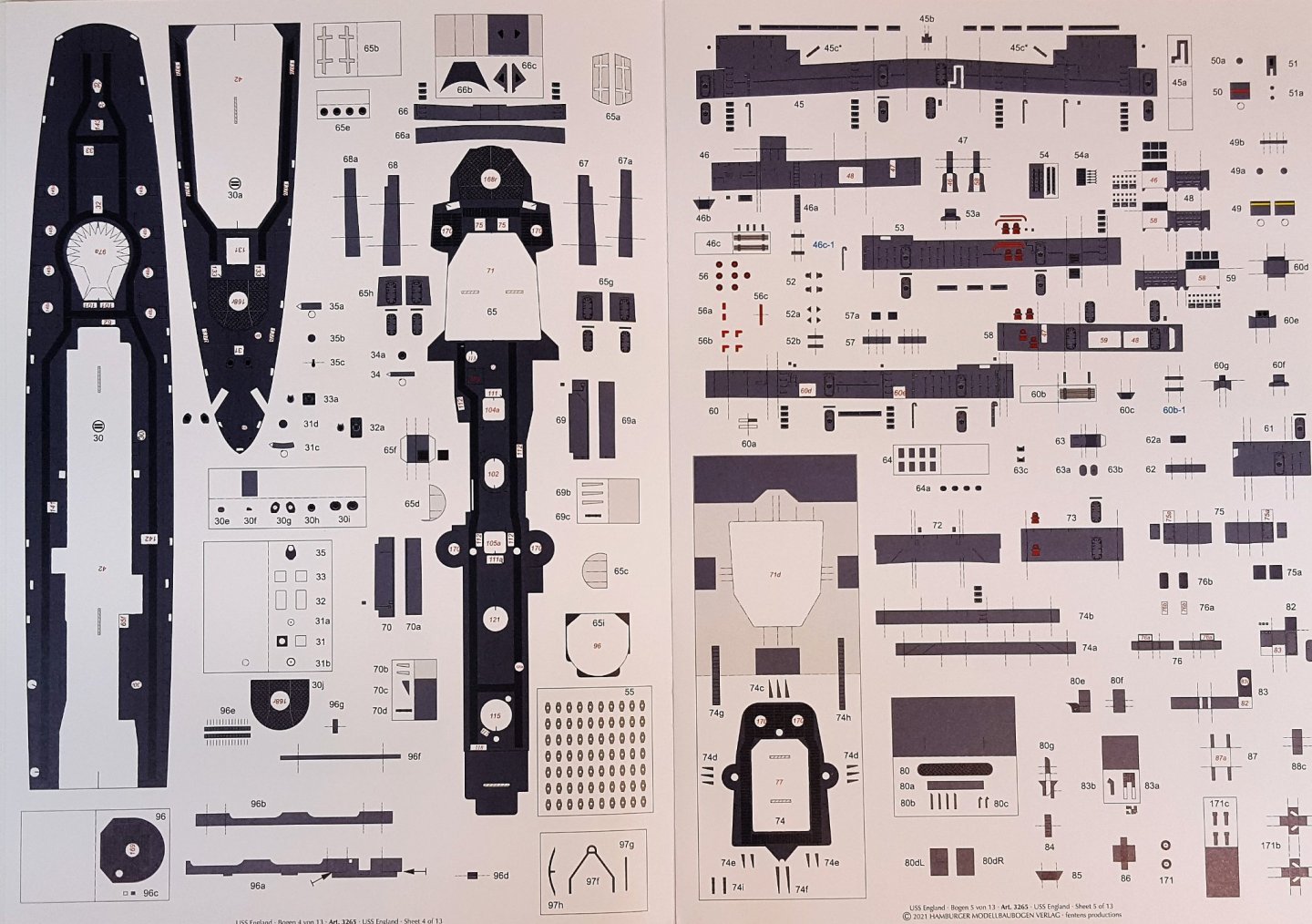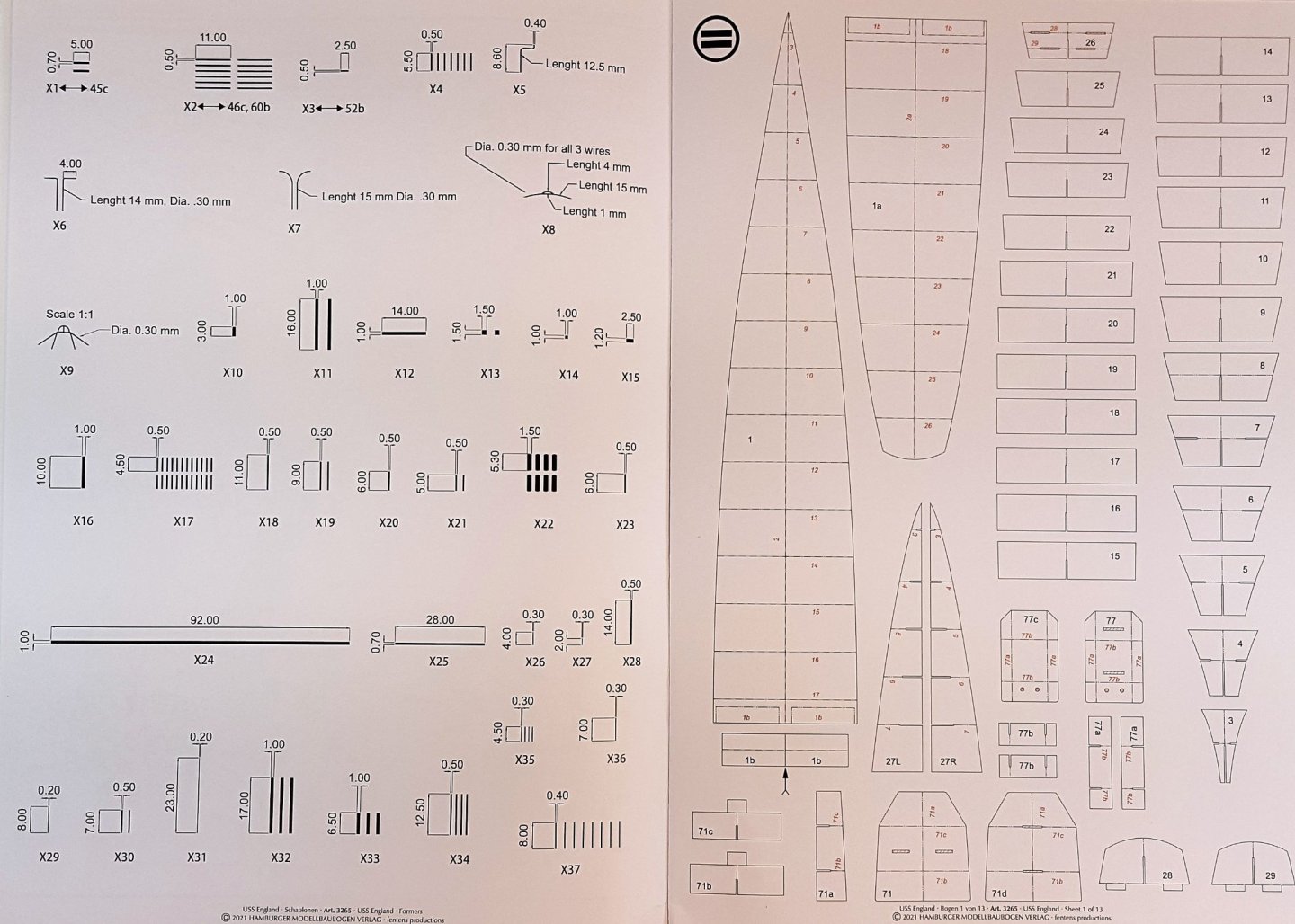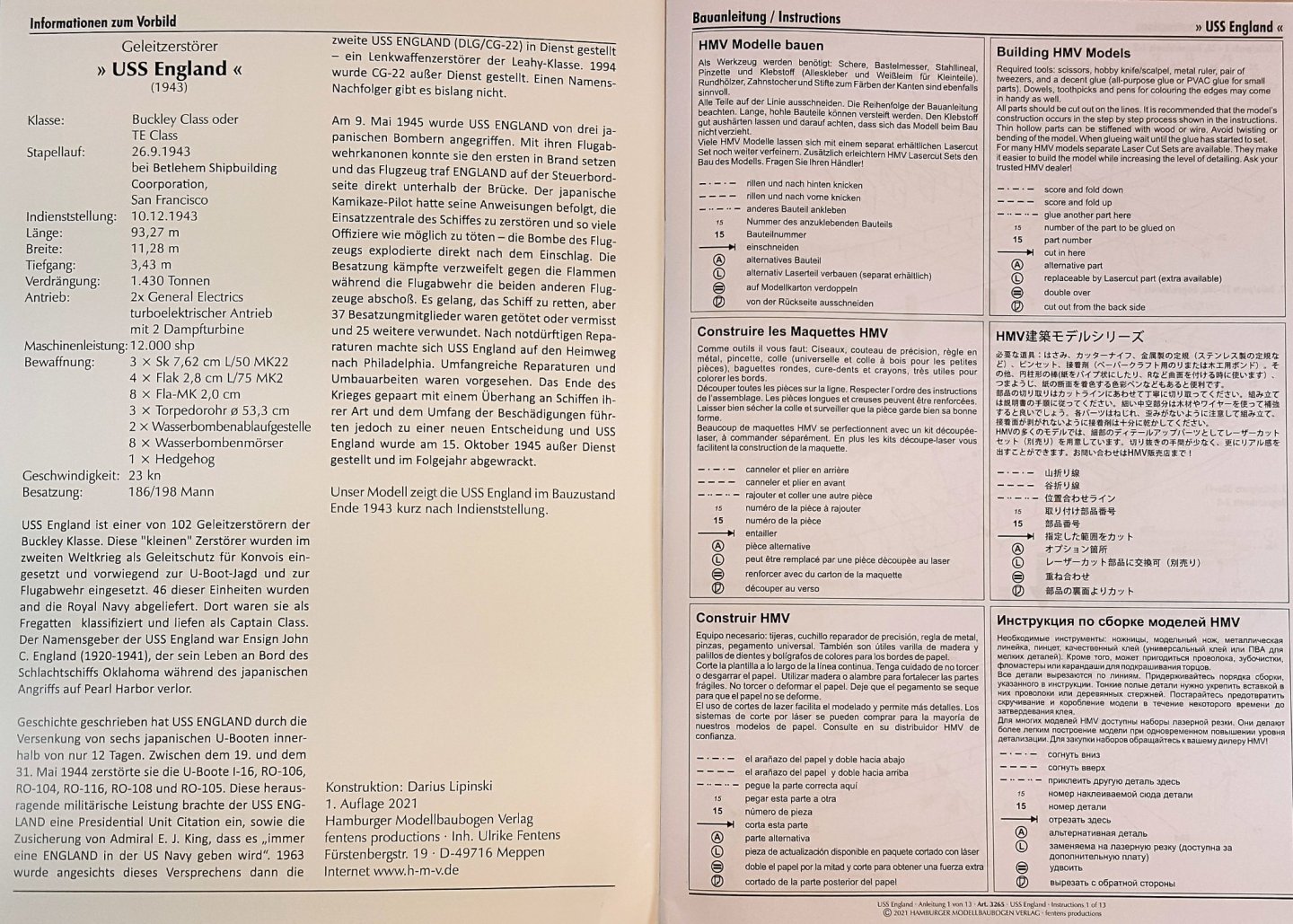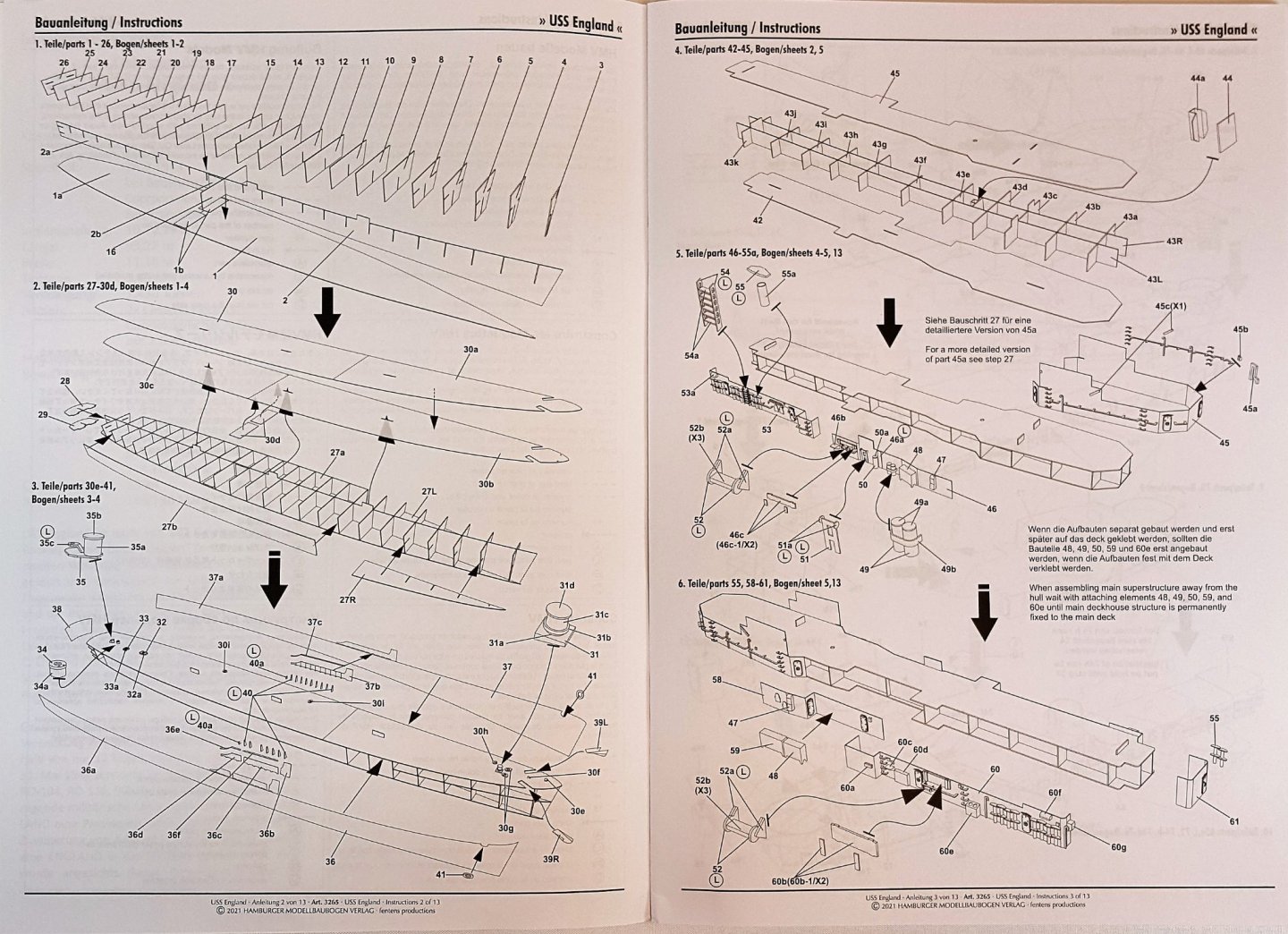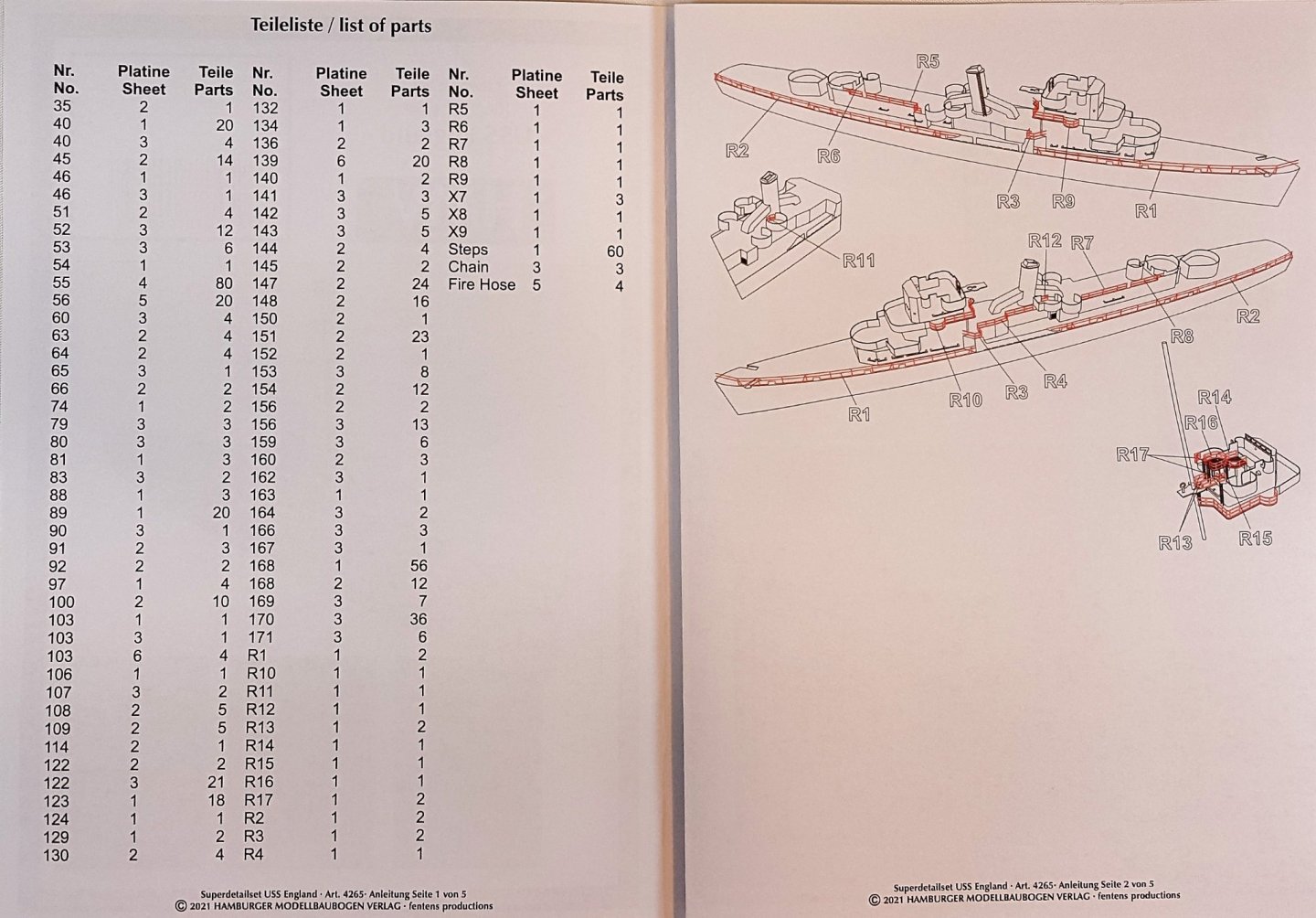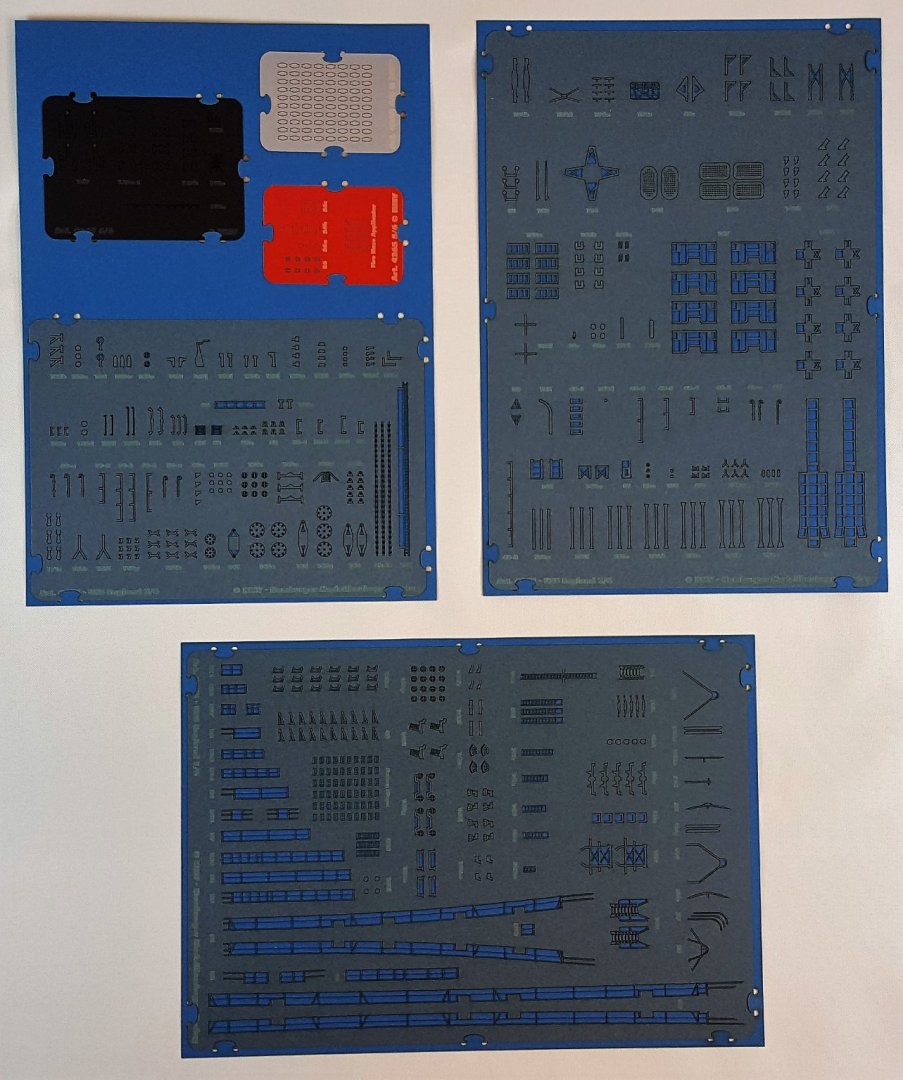Search the Community
Showing results for tags 'England'.
-
Okay, back to ships! I'm really biting off a lot on this project, but it's such a nice model that I just had to take a crack at it. Hopefully I will be up to the challenge. I wrote a review of this kit, which you can read HERE, so I won't go into great detail about it here. I will, though, repeat that if you like this model and would like to get your hands on a copy, or perhaps try a different card kit, be sure to check out all the HMV kits available from Fentens Papermodels. Unlike my recent aircraft builds, I expect this project to take longer than a month. How long, I can't say. We'll see how it goes and maybe take a break or two if necessary. One nice thing about this project is that I will need only a very small number of edge colors -- the ship is depicted entirely in Measure 21 dark blue-gray. But . . . it has a considerable number of parts -- close to 2000 in total. Ten pages -- wowzers! Happily, I have the laser-cut detail set to replace many of those parts. It consists of six frets. And now I can share what Santa brought me this past Christmas. This lovely 3D-printed hull, available from Shapeways, will replace ALL of the usual egg-crate construction. Only the external skins need to be applied. This will be the most stable card ship hull I have ever worked on. So, that will serve for an introduction. The first thing I will need to do is the usual spraying of the parts sheets. Hopefully tomorrow it will be warm enough in the garage to move forward with that task. Cheers!
-
1:250 Destroyer Escort USS ENGLAND (DE-635) HMV Available from Fentens Papermodels €24.99 Photo courtesy of Fentens Papermodels (All photos by the author except where noted.) Fresh off the presses from Hamburger Modellbaubogen Verlag (HMV) comes the Buckley-class destroyer escort USS ENGLAND (DE-635), famous in the annals of anti-submarine warfare for her unmatched feat of sinking six Japanese submarines in the span of only twelve days in May of 1944. You can read more about her exploits here, including how she survived a kamikaze strike in 1945. Public domain photo courtesy of Wikipedia Designed by Darius Lipinski, this exciting new release from HMV is in their usual scale of 1/250 and produces a model 372 mm in length (14.6 in.). The first thing one notices is the striking packaging -- the kit comes in booklet form, the cover shows several views of the completed prototype model, and the back cover features a montage of other HMV kit covers. You might also notice several interesting numbers -- the parts count on this one is a hefty 1567 (up to 1875 if all optional parts are used) printed on 11 sheets. England is printed in 1944's Measure 21 uniform dark blue-grey. The printing is sharp with excellent registration. A lot of parts in this kit end up visible on two sides, and these parts are all given reverse-side printing. A nice touch on this and other newer HMV kits is that the fold lines are no longer printed directly on the parts but rather adjacent to them. The instructions consist of a whopping 28 diagrams that cover every facet of construction. A brief introduction on how to interpret the symbols used on the diagrams is included in six languages: German, English, French, Japanese, Spanish, and Russian. Parts marked "A" can be replaced or enhanced with alternative parts that raise the level of detail. Parts marked "L" can be replaced with optional laser-cut details. A departure from previous HMV kits is that the "egg crate" hull construction has been significantly beefed up, with many more transverse bulkheads added and some parts doubled for additional strength (as indicated by a block-style "=" sign). The internal formers also do not include the typical gluing tabs that are normally used for attaching the hull sides. Overall, this method is more in line with that used by most Eastern European publishers, and I anticipate that this will make for easier hull construction and a more rigid substructure. As you can see, this is an incredibly detailed kit with a lot of very small parts, making this kit deserving of its schwierig (difficult) rating. Potential builders should definitely have a few completed card models under their belts before attempting this project. One way to simplify construction is to invest in the optional laser-cut detail set. This €29.99 option includes five frets of parts, including railings, ladders, davits, and other small parts. Replacing the railings and the multitude of "fiddly bits" with parts from the laser-cut set eliminates the tedium of cutting those delicate parts out and improves the finished look of the model. Personally, I feel that the time savings and the inherent neatness of the laser-cut parts makes them well worth the additional cost. The level of detail of this model, coupled with the fantastic appearance of the finished product, show again why HMV are considered a top-shelf card model publisher. But despite the kit's complexity, it is apparent that HMV have taken pains to ensure that a reasonably skilled builder is given every possible advantage toward finishing a very impressive, medium-sized model. The kit's wealth of detail and great choice of subject will no doubt make this kit a big seller. This author hopes that HMV will soon follow this design up with additional small warship subjects. If they do, we'll be sure to let you know! Thanks go to Fentens Papermodels for providing this review copy, which was securely packed to survive the journey across the pond and arrived in excellent condition. To purchase, visit the Fentens Papermodels website via the link at the top of this post -- they have a lot of really neat models in stock. If you place an order, be sure to tell them that Model Ship World sent you! Photo courtesy of Fentens Papermodels Photo courtesy of Fentens Papermodels Photo courtesy of Fentens Papermodels Photo courtesy of Fentens Papermodels
-
For my 3rd plastic kit build, I've chosen the 1:350 Trumpeter USS England (DE-635) Destroyer Escort kit. Background: USS England DE-635 Length : 93.2 m (305.77 ft) Beam : 11.2 m (36.7 ft) Displacement : 1400K (1.377 Long tons) The USS England was one of 142 turbo-electric (TE) series destroyer escorts commissioned between April 1943 and March 1944. Named after Ensign Charles England who was killed onboard the Oklahoma (BB-37) on 7 December 1941 attack on Pearl Harbor. She was commissioned on 10 December 1943, arrived at Espiritu Santo on 12 March 1944, from where she was engaged in escort duties. Between 19 May and 31 May 1944, England, in company with George (DE-657), Raby (DE-698), and Spangler (DE-696), stalked and sank six Japanese submarines. with MK-10 "Hedgehog" Projector and Depth Charges. Following the successes against the six submarines, England continued to operate as convoy escort and was involved with operations against Leyte, Iwo Jima, and Okinawa. In the end of the war, England was decomissioned on 10 December 1945. The kit includes PE Brass depth charge racks, and I've also purchase the Tom's ModelWorks PE kit for this model. I will be painting it with the WWII "razzle-dazzle" camouflage, using as a reference the actual museum ship, Destroyer Escort USS Slater (DE-766), which is on display just north of me in Albany, NY. Obligatory box photos: Included PE Tom's ModelWorks PE alongside the kit supplied PE The "razzle-dazzle" camo scheme: Photos from the USS Slater website
-
GOING DUTCH: How England Plundered Holland’s Glory LISA JARDINE Paperback: 432 pages Publisher: Harper Perennial; Reprint edition (September 1, 2009) Language: English ISBN-10: 0060774096 ISBN-13: 978-0060774097 This is a very interesting book about the Dutch and the British. There is a large section on how the Dutch invaded England. Something the history books forgot to mention. It is very detailed. I enjoyed reading about this and much has been written on this era of the Netherlands. The following is an excerpt from the book. It is loooooong, and amazing..... This is a book about cultural exchange between England and the Dutch Republic – an extraordinary process of cross-fertilization which took place in the seventeenth century, between the life and thought of two rapidly developing countries in northern Europe. The two territories, jostling for power on the world stage, politically and commercially, recognized that they had a great deal in common. Still, each of them represented itself – and has continued to do so ever since – as absolutely independent and unique. In Going Dutch, renowned writer Lisa Jardine tells the remarkable history of the relationship between England and Holland, two of Europe’s most important colonial powers at the dawn of the modern age. Jardine, the author of The Awful End of Prince William the Silent, demonstrates that England’s rise did not come at the expense of the Dutch as is commonly thought, but was actually a “handing on” of the baton of cultural and intellectual supremacy to a nation expanding in international power and influence. On 1 November 1688 Prince William of Orange, elected ruler or Stadholder of the Dutch Republic, and husband of the English King James II’s eldest daughter, Mary Stuart, embarked upon a seaborne invasion of the British Isles. His invasion force consisted of an astounding five hundred ships, an army of more than twenty thousand highly trained professional troops, and a further twenty thousand mariners and support staff. As a naval and military undertaking, the sheer scale, temerity and bold ambition of the venture captured the European imagination for years afterwards. The exact numbers of the invading forces were a matter of dispute and deliberate exaggeration (and have remained so ever since), but there was no uncertainty at all about William of Orange’s intentions – this was a redoubtable force, and it was headed for the English coast. The joint naval and military operation was on an unprecedented scale. Its meticulous organization astonished political observers. William, it slowly emerged, had started to build up his army in the first half of 1688, without consulting the Dutch government – the States General. close friends shuttled clandestinely around Europe for months securing backing from those known to be sympathetic to the Protestant cause, and negotiating supporting troops and financial loans. Between June and October they surreptitiously assembled a massive force of well-trained, well-paid and experienced soldiers drawn from right across Protestant Europe. From the very start, the Dutch fleet achieved its key strategic aim, creating an unforgettable spectacle, inducing a feeling of shock and awe in onlookers on either shore. The boldest enterprise ever undertaken by the Republic of the United Netherlands was stage-managed with exquisite artistry. The expedition comprised fifty-three warships, of which thirty-two were ‘capital ships’ designed for combat – thirteen with between sixty and sixty-eight guns, seven with between fifty and fifty-six, and twelve with between forty and forty-eight – the rest escort ships. There were ten fire ships and about four hundred other vessels to transport troops, supplies and horses. The army was made up of 10,692 regular infantry and 3,660 regular cavalry, plus gunners of the artillery train and five thousand gentleman volunteers – expatriate Englishmen, Huguenots and other sympathizers. On top of this there were 9,142 crew members and a further ten thousand men on board the transport vessels. William’s plan was that this spectacular floating combination of forces and resources should avoid naval engagement at all costs. Like the D-Day landings, this was a huge feat of transportation, rather than a navy seeking a sea battle. The munitions, equipment and supplies with which the expeditionary force was provided were formidable, and state-of-the-art. According to one eyewitness (who, as usual, may have slightly exaggerated the numbers), the fleet carried a total of seven thousand horses – mounts for the 3,660 cavalry officers, the Prince, his entourage and the officer and gentleman volunteers, and draught horses for the carts carrying provisions and ammunition. Further draught animals were needed to pull the fifty artillery pieces. Responding to the favorable wind, the invasion fleet proceeded in the direction of the English coast, headed towards Harwich, as if to make landfall in Yorkshire. Having sailed just past Harwich, however, William of Orange, commander-in-chief in person of this mighty flotilla, gave new orders for it to proceed instead south-westwards, to take full advantage of the ever-strengthening easterly wind. The English war fleet, trapped in the Thames estuary by the same wind, watched William’s armada go by twice, helpless to follow and engage until it was too late. The Dutch made landfall at Baxton. On 18 December the Prince of Orange and his army entered London in another carefully organized ‘triumph’, to be welcomed, this time, by cheering crowds of Londoners. The Dutch invasion of 1688 was a brilliantly stage-managed sequence of events, forever vivid in the memory of those who witnessed them. The entire London area remained under Dutch military occupation until the spring of 1690. No English regiments were allowed within twenty miles of the city. The English and Scots regiments of the States General’s forces, which had led the triumphal entry (in order not to alarm the citizens of London too much) were stationed at the Tower and Lambeth. Dutch and German regiments encamped at Woolwich, Kensington, Chelsea and Paddington, while another crack regiment was positioned at Richmond, and the Huguenots put up in various parts of London. So why is there almost no trace of this vast, hostile armada, with its dramatic progress along the English Channel, its fanfares and gun-salutes and parading battalions, in conventional historical accounts of the so-called ‘Glorious Revolution’? Why are many of us unaware of the fact that at the time of the English Parliament’s ‘welcoming’ William and his wife Mary Stuart, and subsequently, in early 1689, inviting them jointly to ascend the English throne, the country was in the grip of full-scale military occupation, with Dutch troops posted in front of key buildings throughout London, and growing unrest and resentment throughout the land? One obvious reason for this historical amnesia is the enduring impact and lasting success of the propaganda offensive launched by William of Orange even before he left Dutch shores. Surviving documents tend to exert a strong influence over retrospective historical interpretation – they are the stuff of which narrative history and interpretation are made. This book discusses the invasion in much detail and how the Brits and the Dutch have so much in common. Any Dutchman on this site should read this book. Thanks for reading Marc One more comment: Lisa Jardine's general purpose is to show that England stole from, copied, imitated and was influenced by the Netherlands during the seventeenth century. From state formation to garden-design, England learned from the Dutch. Thus, Jardine suggests, England isn't wholly English, since so much of its culture is imported, originally foreign, or hybrid. This will surprise people that have very little background in history, but most of us should know that the English, like all societies, learned from or were influenced by many people. Jardine never tells us, nor even asks, whether Dutch influence was more profound on the English than French, Italian, Scottish, Irish, Turkish, American, Spanish, or Indian culture was, though of course all were important in various ways. Nor does she have a very illuminating picture of what the Netherlands actually are - she implies that this rapidly changing and heterogeneous society was monolithic. I could go on, but suffice it to say that Jardine's story is a bit simple-minded and naïve. Readers with much background in 17th century history won't learn much, and would do better looking over her footnotes and simply reading those books instead. Jardine is a professor of history, but this book, like many of her others, in fact, reveal very little if any original research. This book simply doesn't tell the world anything that wasn't already available elsewhere. For those interested in the topics explored here, I would recommend instead Jan de Vries' new synthesis of Dutch and European economic growth, The Industrious Revolution. Tulipmania by Anne Goldgar is a very interesting study of flowers and collecting that reveals much about 17th century Dutch culture, and Jonathan Israel has written many of the best English-language studies of the Netherlands. Those books are thought-provoking and original.
About us
Modelshipworld - Advancing Ship Modeling through Research
SSL Secured
Your security is important for us so this Website is SSL-Secured
NRG Mailing Address
Nautical Research Guild
237 South Lincoln Street
Westmont IL, 60559-1917
Model Ship World ® and the MSW logo are Registered Trademarks, and belong to the Nautical Research Guild (United States Patent and Trademark Office: No. 6,929,264 & No. 6,929,274, registered Dec. 20, 2022)
Helpful Links
About the NRG
If you enjoy building ship models that are historically accurate as well as beautiful, then The Nautical Research Guild (NRG) is just right for you.
The Guild is a non-profit educational organization whose mission is to “Advance Ship Modeling Through Research”. We provide support to our members in their efforts to raise the quality of their model ships.
The Nautical Research Guild has published our world-renowned quarterly magazine, The Nautical Research Journal, since 1955. The pages of the Journal are full of articles by accomplished ship modelers who show you how they create those exquisite details on their models, and by maritime historians who show you the correct details to build. The Journal is available in both print and digital editions. Go to the NRG web site (www.thenrg.org) to download a complimentary digital copy of the Journal. The NRG also publishes plan sets, books and compilations of back issues of the Journal and the former Ships in Scale and Model Ship Builder magazines.


